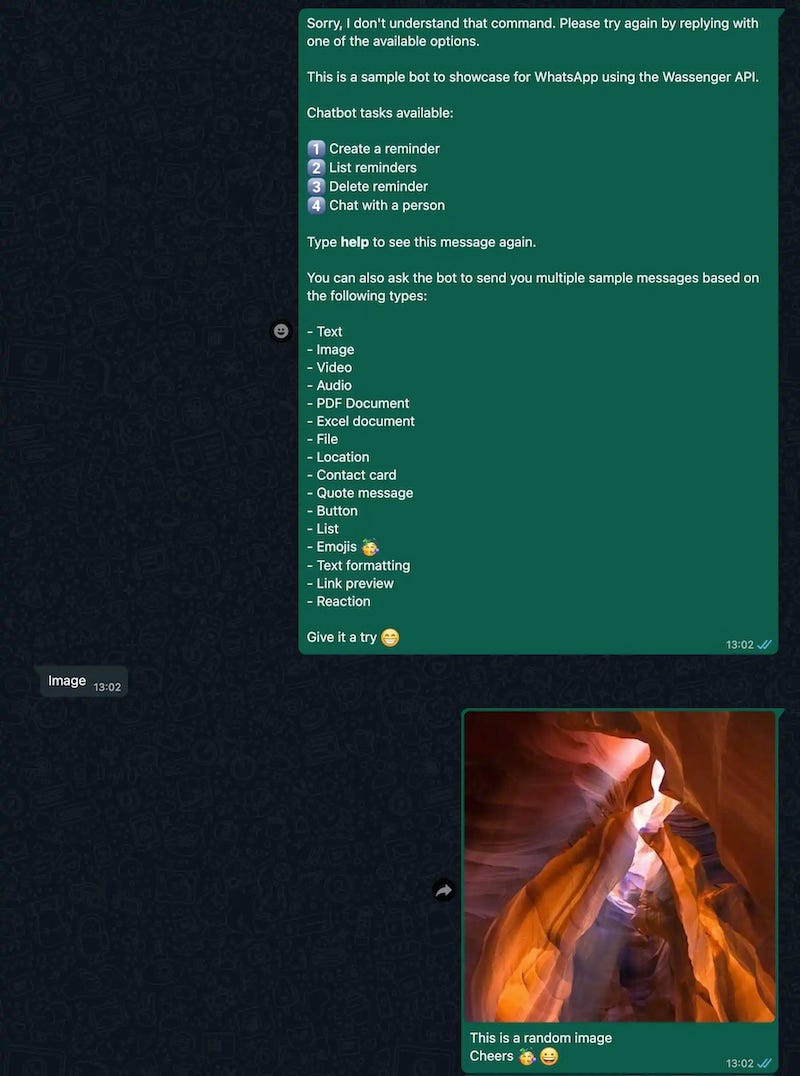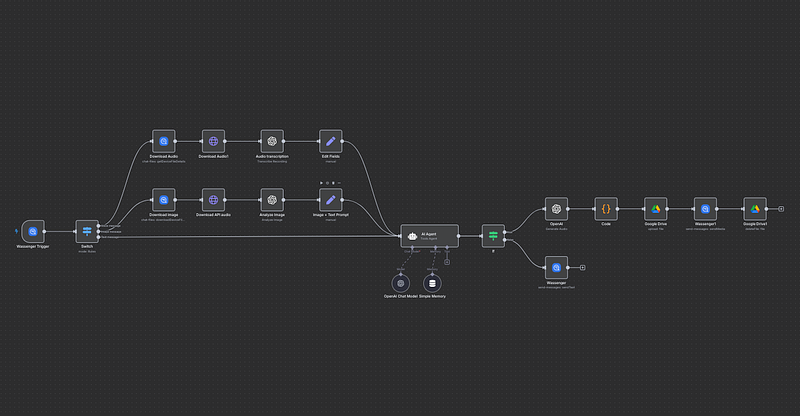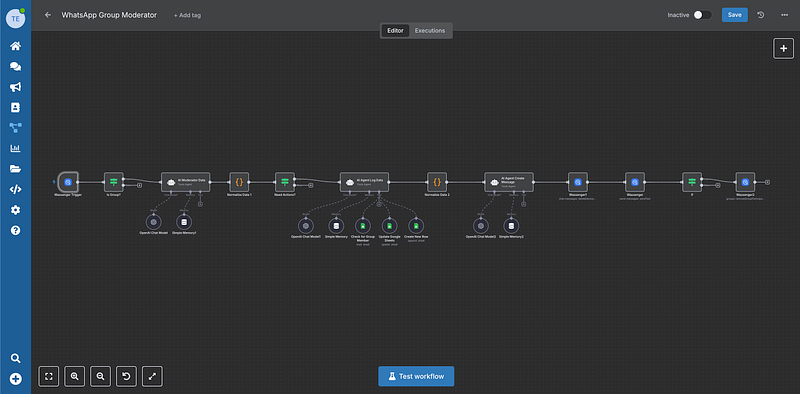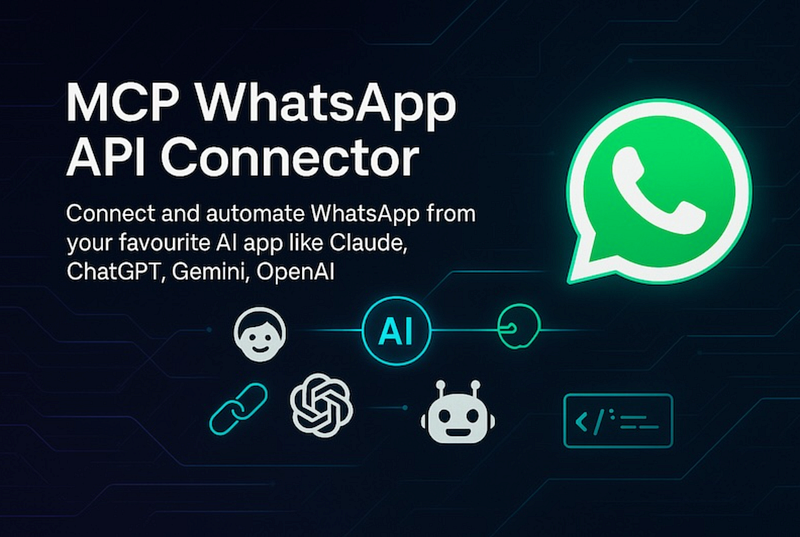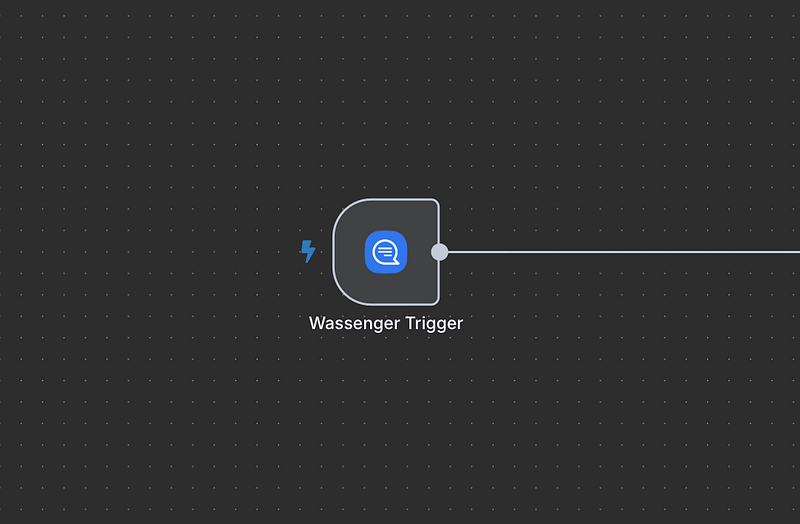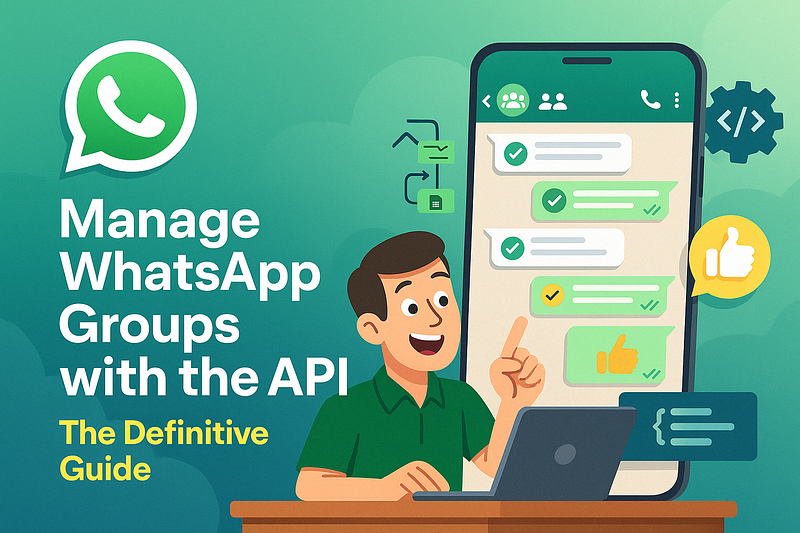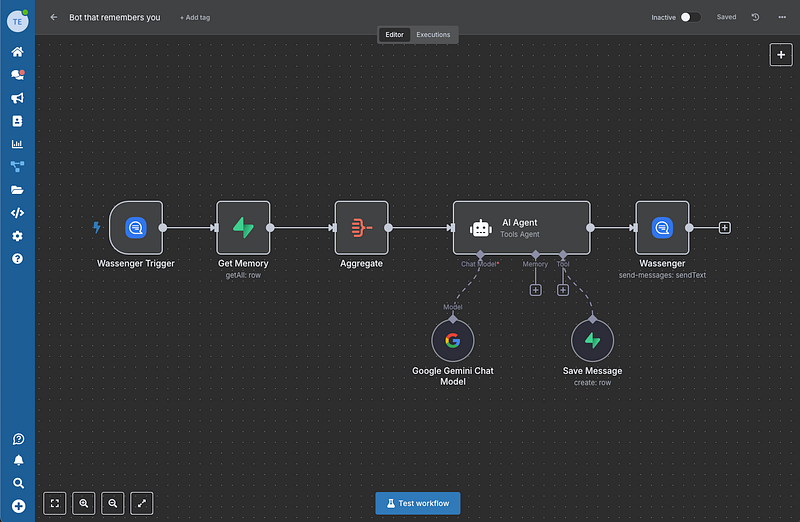Construye un chatbot de WhatsApp totalmente personalizable y listo para usar en minutos, usando Node.js y la Wassenger API 🤖 🤩
Pon en funcionamiento un chatbot en minutos en tu equipo o servidor y adáptalo fácilmente para cubrir tus casos de uso específicos.
En este tutorial, podrás ejecutar un chatbot funcional que puede crear, editar y eliminar recordatorios bajo demanda, asignar chats a agentes cuando se solicite y responder con diferentes mensajes de ejemplo según lo pidan los usuarios.
👉 Descarga el código de este tutorial aquí
🤖 ¿Buscas un chatbot potenciado por IA? Explora este tutorial
🤩 Wassenger es una solución completa de API para WhatsApp. Regístrate para una prueba gratuita de 7 días y empieza en minutos !
Características
Este tutorial proporciona una implementación completa de un chatbot en Node.js que hace lo siguiente:
- Proporciona un chatbot completamente funcional en tu número de WhatsApp conectado a Wassenger
- Responde automáticamente los mensajes entrantes de los usuarios
- Permite a cualquier usuario crear, listar y eliminar recordatorios de mensajes
- Permite a cualquier usuario solicitar hablar con una persona, en cuyo caso el chat será asignado a un agente
- Envía un mensaje de ejemplo al usuario según su entrada (imagen, video, audio, documento, ubicación…)
- Configura el comportamiento del chatbot fácilmente usando el archivo de configuración
Tareas soportadas por el chatbot
1️⃣ Crear un recordatorio
2️⃣ Listar recordatorios
3️⃣ Eliminar recordatorio
4️⃣ Conversar con una persona
Además, el chatbot puede enviarte los siguientes mensajes de ejemplo:
- Texto
- Imagen
- Vídeo
- Audio
- Documento PDF
- Documento Excel
- Archivo
- Botones
- Lista
- Ubicación
- Tarjeta de contacto
- Mensaje citado
- Emojis 🥳
- Formato de texto
- Vista previa de enlace
- Reacción
🤑 💰 Gana 30% de comisión refiriendo usuarios a Wassenger. Obtén tu enlace de referido ahora. Aplican términos .
Cómo funciona
El programa validará que tienes acceso a la Wassenger API y que tienes al menos un número de WhatsApp conectado.
Crea un túnel usando Ngrok para poder recibir eventos Webhook en tu equipo (o puedes usar una URL de Webhook dedicada si ejecutas el bot en un servidor en la nube).
Registra el endpoint webhook automáticamente.
Comienza a escuchar los mensajes entrantes recibidos en tu número de WhatsApp.
Puedes empezar a probar el bot enviando mensajes al número de WhatsApp conectado.
Comportamiento del chatbot
El chatbot siempre responderá a los mensajes en base a las siguientes condiciones:
- El chat pertenece a un usuario (los chats de grupo siempre se ignoran)
- El chat no está asignado a ningún agente dentro de Wassenger
- El chat no tiene ninguna de las etiquetas en la lista negra (ver config.js)
- El número del usuario del chat no ha sido puesto en la lista negra (ver config.js)
- El chat o el contacto no ha sido archivado o bloqueado
Requisitos
- Node.js ( descargar)
- Número personal o Business de WhatsApp
- Clave de API de Wassenger ( regístrate aquí gratis)
- Conecta tu número de WhatsApp a Wassenger
- Regístrate para una cuenta gratuita de Ngrok para crear un túnel webhook (solo si ejecutas el bot en tu equipo local)
Estructura del proyecto
\
|- bot.js -> the bot source code in a single file
|- config.js -> configuration file to customize the bot behavior and rules
|- package.json -> node.js package manifest required to install dependencies
|- node_modules -> where the project dependencies will be installed, fully managed by npm
Uso
Abre tu terminal favorito y cambia el directorio a la carpeta del proyecto donde se encuentra package.json:
cd ~Downloads/whatsapp-chatbot-demo-tutorial/
Desde esa carpeta, instala las dependencias con npm:
npm install
Con tu editor de código preferido, edita config.js e ingresa tu clave API de Wassenger ( regístrate aquí gratis) y coloca la API key en la línea 12:
// Required.Specify the Wassenger API key to be used
// You can obtain it here: https://app.wassenger.com/apikeys
apikey: env.API_KEY || 'ENTER API KEY HERE';
Si quieres ejecutar el programa en tu equipo, necesitas crear un túnel con Ngrok. — Regístrate para una cuenta gratuita de Ngrok y obtén tu token de autenticación como se explica aquí. Luego colócalo en la línea 29:
// Ngrok tunnel authentication token.
// Required if webhook URL is not provided.
// sign up for free and get one: https://ngrok.com/signup
// Learn how to obtain the auth token: https://ngrok.com/docs/agent/#authtokens
ngrokToken: env.NGROK_TOKEN,
Ejecuta el programa del bot:
node bot
Ejecuta el programa del bot en un puerto personalizado:
PORT= 80 node bot
Ejecuta el programa del bot para un dispositivo específico conectado a Wassenger:
DEVICE=WHATSAPP_DEVICE_ID node bot
Ejecuta el programa del bot en modo producción:
NODE_ENV=production node bot
Ejecuta el bot con un servidor webhook existente sin el túnel Ngrok:
WEBHOOK_URL=https://bot.company.com:8080/webhook node bot
Nota: https://bot.company.com:8080 debe apuntar al programa del bot que se está ejecutando en tu servidor y ser accesible por la red usando HTTPS para una conexión segura.
🤑 💰 Gana 30% de comisión refiriendo usuarios a Wassenger. Obtén tu enlace de referido ahora. Aplican términos .
Archivos fuente
Descarga todos los archivos del proyecto haciendo clic aquí.
https://github.com/wassengerhq/whatsapp-chatbot-demo-tutorial/blob/master/config.js
Archivo de configuración del bot:
El programa del bot. Ábrelo en Github y adáptalo según lo necesites:
const express = require('express')
const axios = require('axios')
const ngrok = require('ngrok')
const moment = require('moment')
const nodemon = require('nodemon')
const bodyParser = require('body-parser')
const config = require('./config')
const { env } = process
// Base URL API endpoint.Do not edit!
const API_URL = env.API_URL || 'https://api.wassenger.com/v1'
// Create web server
const app = express()
// Middleware to parse incoming request bodies
app.use(bodyParser.json())
// Index route
app.get('/', (req, res) => {
res.send({
name: 'chatbot',
description: 'Simple WhatsApp chatbot for Wassenger',
endpoints: {
webhook: {
path: '/webhook',
method: 'POST'
},
sendMessage: {
path: '/message',
method: 'POST'
},
sample: {
path: '/sample',
method: 'GET'
}
}
})
})
// POST route to handle incoming webhook messages
app.post('/webhook', (req, res) => {
const { body } = req
if(!body || !body.event || !body.data) {
return res.status(400).send({ message: 'Invalid payload body' })
}
if(body.event !== 'message:in:new') {
return res.status(202).send({ message: 'Ignore webhook event: only message:in:new is accepted' })
}
res.send({ ok: true })
// Process message in background
processMessage(body).catch(err => {
console.error('[error] failed to process inbound message:', body.id, body.data.fromNumber, body.data.body, err)
})
})
// Send message on demand
app.post('/message', (req, res) => {
const { body } = req
if(!body || !body.phone || !body.message) {
return res.status(400).send({ message: 'Invalid payload body' })
}
sendMessage(body).then((data) => {
res.send(data)
}).catch(err => {
res.status(+err.status || 500).send(err.response ? err.response.data: {
message: 'Failed to send message'
})
})
})
// Send a sample message to your own number, or to a number specified in the query string
app.get('/sample', (req, res) => {
const { phone, message } = req.query
const data = {
phone: phone || app.device.phone,
message: message || 'Hello World from Wassenger!',
device: app.device.id
}
sendMessage(data).then((data) => {
res.send(data)
}).catch(err => {
res.status(+err.status || 500).send(err.response ? err.response.data: {
message: 'Failed to send sample message'
})
})
})
app.use((err, req, res, next) => {
res.status(+err.status || 500).send({
message: `Unexpected error: ${err.message}`
})
})
const welcomeMessage = `Hey there 👋 Welcome to this chatbot demo!`
const unknownCommandMessage = `Sorry, I don 't understand that command.Please try again by replying with one of the available options.`
const defaultMessage = `This is a sample bot to showcase for WhatsApp using the Wassenger API.
Chatbot tasks available:
1️⃣ Create a reminder
2️⃣ List reminders
3️⃣ Delete reminder
4️⃣ Chat with a person
Type *help* to see this message again.
You can also ask the bot to send you multiple sample messages based on the following types:
- Text
- Image
- Video
- Audio
- PDF Document
- Excel document
- File
- Location
- Contact card
- Quote message
- Button
- List
- Emojis 🥳
- Text formatting
- Link preview
- Reaction
Give it a try 😁
`
// In-memory store for a simple state machine per chat
// You can use a database instead for persistence
const state = {}
const reminders = {}
// In-memory cache store
const cache = {}
const cacheTTL = 10 * 60 * 1000 // 10 min
async function pullMembers(device) {
if(cache.members && +cache.members.time && (Date.now() - +cache.members.time) < cacheTTL) {
return cache.members.data
}
const url = `${API_URL}/devices/${device.id}/team`
const { data: members } = await axios.get(url, { headers: { Authorization: config.apiKey } })
cache.members = { data: members, time: Date.now() }
return members
}
async function validateMembers(device, members) {
const validateMembers =(config.teamWhitelist || []).concat(config.teamBlacklist || [])
for(const id of validateMembers) {
if(typeof id !== ' string ' || string.length !== 24) {
return exit(' Team user ID in config.teamWhitelist and config.teamBlacklist must be a 24 characters hexadecimal value: ', id)
}
const exists = members.some(user => user.id === id)
if(!exists) {
return exit(' Team user ID in config.teamWhitelist or config.teamBlacklist does not exist: ', id)
}
}
}
async function createLabels(device) {
const labels = cache.labels.data || []
const requiredLabels =(config.setLabelsOnUserAssignment || []).concat(config.setLabelsOnBotChats || [])
const missingLabels = requiredLabels.filter(label => labels.every(l => l.name !== label))
for(const label of missingLabels) {
console.log(' [info] creating missing label: ', label)
const url = `${API_URL}/devices/${device.id}/labels`
const body = {
name: label.slice(0, 30).trim(),
color: [
' tomato ', 'orange ', 'sunflower ', 'bubble ',
' rose ', 'poppy ', 'rouge ', 'raspberry ',
' purple ', 'lavender ', 'violet ', 'pool ',
' emerald ', 'kelly ', 'apple ', 'turquoise ',
' aqua ', 'gold ', 'latte ', 'cocoa '
][Math.floor(Math.random() * 20)],
description: ' Automatically created label for the chatbot '
}
try {
await axios.post(url, body, { headers: { Authorization: config.apiKey } })
} catch(err) {
console.error(' [error] failed to create label: ', label, err.message)
}
}
if(missingLabels.length) {
await pullLabels(device, { force: true })
}
}
async function pullLabels(device, { force } = {}) {
if(!force && cache.labels && +cache.labels.time && (Date.now() - +cache.labels.time) < cacheTTL) {
return cache.labels.data
}
const url = `${API_URL}/devices/${device.id}/labels`
const { data: labels } = await axios.get(url, { headers: { Authorization: config.apiKey } })
cache.labels = { data: labels, time: Date.now() }
return labels
}
async function updateChatLabels({ data, device, labels }) {
const url = `${API_URL}/chat/${device.id}/chats/${data.chat.id}/labels`
const newLabels =(data.chat.labels || [])
for(const label of labels) {
if(newLabels.includes(label)) {
newLabels.push(label)
}
}
if(newLabels.length) {
console.log(' [info] update chat labels: ', data.chat.id, newLabels)
await axios.patch(url, newLabels, { headers: { Authorization: config.apiKey } })
}
}
async function updateChatMetadata({ data, device, metadata }) {
const url = `${API_URL}/chat/${device.id}/contacts/${data.chat.id}/metadata`
const entries = []
const contactMetadata = data.chat.contact.metadata
for(const entry of metadata) {
if(entry && entry.key && entry.value) {
const value = typeof entry.value === ' function' ? entry.value(): value
if(!entry.key || !value || typeof entry.key !== 'string' || typeof value !== 'string') {
continue
}
if(contactMetadata && contactMetadata.some(e => e.key === entry.key && e.value === value)) {
continue // skip if metadata entry is already present
}
entries.push({
key: entry.key.slice(0, 30).trim(),
value: value.slice(0, 1000).trim()
})
}
}
if(entries.length) {
await axios.patch(url, entries, { headers: { Authorization: config.apiKey } })
}
}
async function selectAssignMember(device) {
const members = await pullMembers(device)
const isMemberEligible =(member) => {
if(config.teamBlacklist.length && config.teamBlacklist.includes(member.id)) {
return false
}
if(config.teamWhitelist.length && !config.teamWhitelist.includes(member.id)) {
return false
}
if(config.assignOnlyToOnlineMembers && (member.availability.mode !== 'auto' || ((Date.now() - + new Date(member.lastSeenAt)) > 30 * 60 * 1000))) {
return false
}
if(config.skipTeamRolesFromAssignment && config.skipTeamRolesFromAssignment.some(role => member.role === role)) {
return false
}
return true
}
const activeMembers = members.filter(member => member.status === 'active' && isMemberEligible(member))
if(!activeMembers.length) {
return console.log('[warning] Unable to assign chat: no eligible team members')
}
const targetMember = activeMembers[activeMembers.length * Math.random() | 0]
return targetMember
}
async function assignChat({ member, data, device }) {
const url = `${API_URL}/chat/${device.id}/chats/${data.chat.id}/owner`
const body = { agent: member.id }
await axios.patch(url, body, { headers: { Authorization: config.apiKey } })
if(config.setMetadataOnAssignment && config.setMetadataOnAssignment.length) {
const metadata = config.setMetadataOnAssignment.filter(entry => entry && entry.key && entry.value).map(({ key, value }) =>({ key, value }))
await updateChatMetadata({ data, device, metadata })
}
}
async function assignChatToAgent({ data, device }) {
if(!config.enableMemberChatAssignment) {
return console.log('[debug] Unable to assign chat: member chat assignment is disabled.Enable it in config.enableMemberChatAssignment = true')
}
try {
const member = await selectAssignMember(device)
if(member) {
let updateLabels = []
// Remove labels before chat assigned, if required
if(config.removeLabelsAfterAssignment && config.setLabelsOnBotChats && config.setLabelsOnBotChats.length) {
const labels =(data.chat.labels || []).filter(label => !config.setLabelsOnBotChats.includes(label))
console.log('[info] remove labels before assiging chat to user', data.chat.id, labels)
if(labels.length) {
updateLabels = labels
}
}
// Set labels on chat assignment, if required
if(config.setLabelsOnUserAssignment && config.setLabelsOnUserAssignment.length) {
let labels =(data.chat.labels || [])
if(updateLabels.length) {
labels = labels.filter(label => !updateLabels.includes(label))
}
for(const label of config.setLabelsOnUserAssignment) {
if(!updateLabels.includes(label)) {
updateLabels.push(label)
}
}
}
if(updateLabels.length) {
console.log('[info] set labels on chat assignment to user', data.chat.id, updateLabels)
await updateChatLabels({ data, device, labels: updateLabels })
}
console.log('[info] automatically assign chat to user:', data.chat.id, member.displayName, member.email)
await assignChat({ member, data, device })
} else {
console.log('[info] Unable to assign chat: no eligible or available team members based on the current configuration:', data.chat.id)
}
return member
} catch(err) {
console.error('[error] failed to assign chat:', data.id, data.chat.id, err)
}
}
async function unassignChat({ data, device }) {
try {
const url = `${API_URL}/chat/${device.id}/chats/${data.chat.id}/owner`
await axios.delete(url, null, { headers: { Authorization: config.apiKey } })
} catch(err) {
console.error('[error] failed to unassign chat:', data.id, data.chat.id, err)
}
}
function canReply({ data, device }) {
const { chat } = data
// Skip if chat is already assigned to an team member
if(chat.owner && chat.owner.agent) {
return false
}
// Ignore messages from group chats
if(chat.type !== 'chat') {
return false
}
// Skip replying chat if it has one of the configured labels, when applicable
if(config.skipChatWithLabels && config.skipChatWithLabels.length && chat.labels && chat.labels.length) {
if(config.skipChatWithLabels.some(label => chat.labels.includes(label))) {
return false
}
}
// Only reply to chats that were whitelisted, when applicable
if(config.numbersWhitelist && config.numbersWhitelist.length && chat.fromNumber) {
if(config.numbersWhitelist.some(number => number === chat.fromNumber || chat.fromNumber.slice(1) === number)) {
return true
} else {
return false
}
}
// Skip replying to chats that were explicitly blacklisted, when applicable
if(config.numbersBlacklist && config.numbersBlacklist.length && chat.fromNumber) {
if(config.numbersBlacklist.some(number => number === chat.fromNumber || chat.fromNumber.slice(1) === number)) {
return false
}
}
// Skip replying chats that were archived, when applicable
if(config.skipArchivedChats && (chat.status === 'archived' || chat.waStatus === 'archived')) {
return false
}
// Always ignore replying to banned chats/contacts
if((chat.status === 'banned' || chat.waStatus === 'banned ')) {
return false
}
return true
}
// Process message
async function processMessage({ data, device } = {}) {
// Can reply to this message?
if(! canReply({ data, device })) {
return console.log('[info] Skip message due to chat already assigned or not eligible to reply:', data.fromNumber, data.date, data.body)
}
const { chat, type, quoted } = data
let { body } = data
if(body) {
body = body.trim()
}
// Process list response message selected item by the user
if(type === 'list_response' && quoted.selectedId) {
body = quoted.selectedId
}
const { phone } = chat.contact
console.log('[info] New inbound message received:', chat.id, body || '<empty message>')
const reply = async({ message, ...params }) => {
await sendMessage({
phone,
device: device.id,
message,
...params
})
// Add bot-managed chat labels, if required
if(config.setLabelsOnBotChats.length) {
const labels = config.setLabelsOnBotChats.filter(label =>(data.chat.labels || []).includes(label))
if(labels.length) {
await updateChatLabels({ data, device, labels })
}
}
// Add bot-managed chat metadata, if required
if(config.setMetadataOnBotChats.length) {
const metadata = config.setMetadataOnBotChats.filter(entry => entry && entry.key && entry.value).map(({ key, value }) =>({ key, value }))
await updateChatMetadata({ data, device, metadata })
}
}
// First inbound message, reply with a welcome message
if(!data.chat.lastOutboundMessageAt || data.meta.isFirstMessage) {
const message = `${welcomeMessage}\n\n${defaultMessage}}`
return await reply({ message })
}
// Return to main menu
if(body && body.length < 10 && /help|cancel|stop| exit/i.test(body)) {
body = null
state[chat.id] = null
}
// Assign the chat to an random agent
if(+body === 4 || /human|person|chat|talk/i.test(body)) {
assignChatToAgent({ data, device }).catch(err => {
console.error('[error] failed to assign chat to user:', data.chat.id, err.message)
})
return await reply({
message: `This chat was assigned to a member of our support team.You will be contacted shortly.`,
})
}
const status = state[chat.id]
if(status && status.task === 'reminder-create') {
let message = null
if(status.step === 1 && body === 'x') {
body = null
state[chat.id] = null
}
const items = reminders[chat.id]
if(items && items.length >= 10) {
const message = 'You have reached the maximum number of reminders, please delete one before creating a new one.\n\nReply with *delete* to delete reminders.'
return await reply({ message })
}
if(status.step === 1 && body !== 'x') {
const options = ['1h', '2h', '24h', '2d', '7d', '14d']
if(+body === 7) {
// Cancel option
state[chat.id] = null
} else if(+body >= 1 && +body <= 6) {
message = 'Please reply with a description for the reminder, up to 200 characters.'
state[chat.id] = {
task: 'reminder-create',
time: [options[+body - 1]],
step: 2
}
return await reply({ message })
} else {
state[chat.id] = null
message = 'Invalid option, please reply with one of the available option number(1 to 7)'
body = 'reminder-create'
await reply({ message })
}
}
if(status.step === 2) {
if(!body || body.length < 4) {
return await reply({ message: 'The reminder text is too short, please send a larger description with 5 characters or more.\n\nIf you do not want to continue, just reply with *stop*' })
}
if(body.length > 200) {
return await reply({ message: 'The reminder text is too long, please send a shorter description up to 200 characters.\n\nIf you do not want to continue, just reply with *stop*' })
}
const time = state[chat.id].time
state[chat.id] = null
message = 'All good! I will send you a message when it is time 😀\n\nLet me know if I can do something else for you!'
await reply({ message })
const reminder = `Hi! This is a reminder for you:\n\n${body}`
reminders[chat.id] = reminders[chat.id] || []
const [value, unit] = [+time.slice(0, - 1), time.slice(- 1)]
const date = moment().add(value, unit).toDate()
reminders[chat.id].push({
time,
date,
description: body
})
// Create message reminder at specific date
await reply({ message: reminder, deliverAt: date })
// Send confirmation to user
return await reply({ message })
}
}
if(status && status.task === 'button') {
if(+body === 7 || /cancel|stop| exit/i.test(body)) {
state[chat.id] = null
} else if(+body >= 1 && +body <= 6) {
const samples = ['image', 'location', 'image', 'audio', 'video', 'document']
body = samples[+body - 1]
} else {
// In case of invalid input, send reminder create message again
// body = 'reminder-create'
body = null
state[chat.id] = null
}
}
if(status && status.task === 'reminder-delete') {
if(status.step === 1 && /cancel|stop| exit/i.test(body)) {
body = null
state[chat.id] = null
}
const items = reminders[chat.id]
if(!items || !items.length) {
state[chat.id] = null
return await reply({
message: 'You do not have any reminders yet.\n\nCreate one by replying with *create* or *stop* to return to main menu.'
})
}
if(status.step === 1 && +body >= 1 && +body <= 10) {
const index = +body - 1
const reminder = items[index]
if(!reminder) {
state[chat.id] = null
return await reply({
message: 'The selected reminder was not found.\n\nPlease select a valid reminder by replying *delete* or *stop* to return to main menu.'
})
}
reminders.slice(index, 1)
return await reply({
message: `The following reminder was deleted successfully:\n\ nDate: ${ moment(reminder.date).format('DD/MM/YYYY HH:mm')}\n\ nDescription: ${reminder.description}\n\nReply with *delete* to delete another reminder, *reminders* to list available reminders, or *stop* to return to main menu.`
})
}
}
if(+body === 1 || body === 'reminder-create' || /create|create reminder/i.test(body)) {
state[chat.id] = {
task: 'reminder-create',
step: 1
}
return await reply({
message: 'Please select when you want to be reminded',
header: 'Task reminder',
footer: 'Powered by Wassenger',
buttons: [
{
text: '1 hour'
},
{
text: '2 hours'
},
{
text: '24 hours'
},
{
text: '2 days'
},
{
text: '7 days'
},
{
text: '14 days'
},
{
text: 'Cancel'
}
]
})
}
if(+body === 2 || body === 'reminder-list' || / list reminder|reminders/i.test(body)) {
const items = reminders[chat.id]
if(items && items.length) {
const message = 'Here is a list of your reminders:\n\n' + items.map((item, index) => {
const date = moment(item.date).format('DD/MM/YYYY HH:mm')
return `${index + 1}.${date} - ${item.description}`
}).join('\n\n')
return await reply({ message })
} else {
return await reply({
message: 'You do not have any reminders yet.Create one by replying with *create* or *stop* to return to main menu.'
})
}
}
if(+body === 3 || body === 'reminder-delete' || /delete/i.test(body)) {
const items = reminders[chat.id]
if(!items || !items.length) {
return await reply({
message: 'You do not have any reminders yet.Create one by replying with *create* or *stop* to return to main menu.'
})
}
const rows = items.map((item, index) => {
const date = moment(item.date).format('DD/MM/YYYY HH:mm')
return {
id: `${index}`,
title: `${index + 1}.${date}`,
description: item.description.slice(0, 72)
}
}).slice(0, 10)
state[chat.id] = {
task: 'reminder-delete',
step: 1
}
return await sendMessage({
list: {
description: 'Please select one reminder to delete or reply with *stop* to cancel',
title: 'Task reminder',
button: 'Select one option',
footer: 'Powered by Wassenger',
sections: [
{
title: 'Active reminders',
rows: rows
}
]
}
})
}
if(/button/i.test(body)) {
state[chat.id] = {
task: 'button'
}
return await reply({
phone,
message: 'Select one message type',
device: device.id,
footer: 'You will receive a sample message',
buttons: [
{
text: 'Image'
},
{
text: 'Location'
},
{
text: 'Image'
},
{
text: 'Audio'
},
{
text: 'Video'
},
{
text: 'Document'
},
{
text: 'Cancel'
}
]
})
}
if(/ list/i.test(body)) {
return await reply({
list: {
description: 'Select which type of vehicle you are interested in',
button: 'Tap to select',
title: 'Optional message _title_',
footer: 'Optional *message* footer',
sections: [
{
title: 'Select a car type',
rows: [
{
title: 'Coupe',
id: 'a1',
description: 'This a description for coupe cars'
},
{
title: 'Sports',
id: 'a2',
description: 'This a description for sports cars'
},
{
title: 'SUV',
id: 'a3',
description: 'This a description for SUV cars'
},
{
title: 'Minivan',
id: 'a4',
description: 'This a description for minivan cars'
},
{
title: 'Crossover',
id: 'a5',
description: 'This a description for crossover cars'
},
{
title: 'Wagon',
id: 'a6',
description: 'This a description for wagon cars'
}
]
},
{
title: 'Select a motorbike type',
rows: [
{
title: 'Touring',
id: 'b1',
description: 'Designed to excel at covering long distances'
},
{
title: 'Cruiser',
id: 'b3',
description: 'Harley-Davidsons largely define the cruiser category'
},
{
title: 'Standard',
id: 'b3',
description: 'Motorcycle intended for use on streets and commuting'
}
]
}
]
}
})
}
if(/image/i.test(body)) {
return await reply({
message: 'This is a random image\nCheers 🥳 😀',
media: {
url: 'https://picsum.photos/600'
}
})
}
if(/video/i.test(body)) {
return await reply({
message: 'This is a sample video\nCheers 🥳 😀',
media: {
url: 'https://download.samplelib.com/mp4/sample-5s.mp4'
}
})
}
if(/audio/i.test(body)) {
return await reply({
media: {
url: 'https://download.samplelib.com/mp3/sample-9s.mp3',
format: 'ptt'
}
})
}
if(/location|address/i.test(body)) {
return await reply({
location: {
address: '20 W 34th St., New York, NY 10001, United States'
}
})
}
if(/contact|card/i.test(body)) {
return await reply({
contacts: [
{
name: 'Thomas Anderson',
phone: '+1234567890'
},
{
name: 'John Wick',
phone: '+1234567890'
}
]
})
}
if(/document|pdf/i.test(body)) {
return await reply({
message: 'This is a sample PDF 😀',
media: {
url: 'https://www.w3.org/WAI/ER/tests/xhtml/testfiles/resources/pdf/dummy.pdf'
}
})
}
if(/file|zip/i.test(body)) {
return await reply({
message: 'This is a sample ZIP file 😀',
media: {
url: 'https://www.learningcontainer.com/wp-content/uploads/2020/05/sample-zip-file.zip'
}
})
}
if(/excel|xls/i.test(body)) {
return await reply({
message: 'This is a sample Excel file 😀',
media: {
url: 'https://go.microsoft.com/fwlink/?LinkID=521962'
}
})
}
if(/format/i.test(body)) {
return await reply({
message: 'This message is formatted using _italic format_, *bold format*, ~strikethrough format~ and ```monospace format```'
})
}
if(/quote|reply/i.test(body)) {
return await reply({
message: 'This is a quoted reply to your last message',
quote: data.id
})
}
if(/emoji/i.test(body)) {
return await reply({
message: 'Hello 👋 \nThis is a test message with emojis 👌 😘 😗 😙 😚 😋 😛 😝 😜 copied as text from:\nhttps://getemoji.com\n\nEmojis 👶 👧 🧒 👦 are simply unicode rich characters, so you can copy & paste them as simple text 😀 👏'
})
}
if(/react/i.test(body)) {
return await sendMessage({
phone,
reaction: '👍',
device: device.id,
reactionMessage: data.id
})
}
if(/link|youtube/i.test(body)) {
return await reply({
message: 'Hey checkout this video: https://www.youtube.com/watch?v=dMH0bHeiRNg'
})
}
if(/text/i.test(body)) {
return await reply({
message: 'Hello everyone, and welcome to this demo showcase of a WhatsApp chatbot! 🎉\n\nDuring this demo, you will get a glimpse of the chatbot\'s key features, which include instant customer support, interactive conversations, personalized recommendations, and seamless integration with your existing business processes.We are confident that our chatbot will not only save you time and resources but also foster stronger customer relationships and drive growth for your business.\n\nLet\'s get started! 😀'
})
}
// Default to unknown command response
const unknownCommand = `${unknownCommandMessage}\n\n${defaultMessage}`
await reply({ message: unknownCommand })
}
// Function to send a message using the Wassenger API
async function sendMessage({ phone, message, media, device, ...fields }) {
const url = `${API_URL}/messages`
const body = {
phone,
message,
media,
device,
...fields,
enqueue: 'never'
}
let retries = 3
while(retries) {
retries -= 1
try {
const res = await axios.post(url, body, {
headers: { Authorization: config.apiKey }
})
console.log('[info] Message sent:', phone, res.data.id, res.data.status)
return res.data
} catch(err) {
console.error('[error] failed to send message:', phone, message || (body.list ? body.list.description: '<no message>'), err.response ? err.response.data: err)
}
}
return false
}
// Find an active WhatsApp device connected to the Wassenger API
async function loadDevice() {
const url = `${API_URL}/devices`
const { data } = await axios.get(url, {
headers: { Authorization: config.apiKey }
})
if(config.device && !config.device.includes(' ')) {
if(/^[a-f0- 9]{ 24}$/i.test(config.device) === false) {
return exit('Invalid WhatsApp device ID: must be 24 characers hexadecimal value.Get the device ID here: https://app.wassenger.com/number')
}
return data.find(device => device.id === config.device)
}
return data.find(device => device.status === 'operative')
}
// Function to register a Ngrok tunnel webhook for the chatbot
// Only used in local development mode
async function registerWebhook(tunnel, device) {
const webhookUrl = `${tunnel}/webhook`
const url = `${API_URL}/webhooks`
const { data: webhooks } = await axios.get(url, {
headers: { Authorization: config.apiKey }
})
const findWebhook = webhook => {
return(
webhook.url === webhookUrl &&
webhook.device === device.id &&
webhook.status === 'active' &&
webhook.events.includes('message:in:new')
)
}
// If webhook already exists, return it
const existing = webhooks.find(findWebhook)
if(existing) {
return existing
}
for(const webhook of webhooks) {
// Delete previous ngrok webhooks
if(webhook.url.includes('ngrok-free.app') || webhook.url.startsWith(tunnel)) {
const url = `${API_URL}/webhooks/${webhook.id}`
await axios.delete(url, { headers: { Authorization: config.apiKey } })
}
}
await new Promise(resolve => setTimeout(resolve, 500))
const data = {
url: webhookUrl,
name: 'Chatbot',
events: ['message:in:new'],
device: device.id
}
const { data: webhook } = await axios.post(url, data, {
headers: { Authorization: config.apiKey }
})
return webhook
}
// Function to create a Ngrok tunnel and register the webhook dynamically
async function createTunnel() {
let retries = 3
while(retries) {
retries -= 1
try {
const tunnel = await ngrok.connect({
addr: config.port,
authtoken: config.ngrokToken
})
console.log(`Ngrok tunnel created: ${tunnel}`)
return tunnel
} catch(err) {
console.error('[error] Failed to create Ngrok tunnel:', err.message)
await ngrok.kill()
await new Promise(resolve => setTimeout(resolve, 1000))
}
}
throw new Error('Failed to create Ngrok tunnel')
}
// Development server using nodemon to restart the bot on file changes
async function devServer() {
const tunnel = await createTunnel()
nodemon({
script: 'bot.js',
ext: 'js',
watch: ['*.js', 'src/**/*.js'],
exec: `WEBHOOK_URL=${tunnel} DEV= false npm run start`,
}).on('restart', () => {
console.log('[info] Restarting bot after changes...')
}).on('quit', () => {
console.log('[info] Closing bot...')
ngrok.kill().then(() => process.exit(0))
})
}
function exit(msg, ...args) {
console.error('[error]', msg, ...args)
process.exit(1)
}
// Initialize chatbot server
async function main() {
// API key must be provided
if(!config.apiKey || config.apiKey.length < 60) {
return exit('Please sign up in Wassenger and obtain your API key here:\nhttps://app.wassenger.com/apikeys')
}
// Create dev mode server with Ngrok tunnel and nodemon
if(env.DEV === 'true' && !config.production) {
return devServer()
}
// Find a WhatsApp number connected to the Wassenger API
const device = await loadDevice()
if(!device) {
return exit('No active WhatsApp numbers in your account.Please connect a WhatsApp number in your Wassenger account:\nhttps://app.wassenger.com/create')
}
if(device.session.status !== 'online') {
return exit(`WhatsApp number(${device.alias}) is not online.Please make sure the WhatsApp number in your Wassenger account is properly connected:\nhttps: //app.wassenger.com/${device.id}/scan`)
}
if(device.billing.subscription.product !== 'io') {
return exit(`WhatsApp number plan(${device.alias}) does not support inbound messages.Please upgrade the plan here:\nhttps: //app.wassenger.com/${device.id}/plan?product=io`)
}
// Pre-load device labels and team mebers
const [members] = await Promise.all([
pullMembers(device),
pullLabels(device)
])
// Create labels if they don't exist
await createLabels(device)
// Validate whitelisted and blacklisted members exist
await validateMembers(members)
app.device = device
console.log('[info] Using WhatsApp connected number:', device.phone, device.alias, `(ID = ${device.id})`)
// Start server
await app.listen(config.port, () => {
console.log(`Server listening on port ${config.port}`)
})
if(config.production) {
console.log('[info] Validating webhook endpoint...')
if(!config.webhookUrl) {
return exit('Missing required environment variable: WEBHOOK_URL must be present in production mode')
}
const webhook = await registerWebhook(config.webhookUrl, device)
if(!webhook) {
return exit(`Missing webhook active endpoint in production mode: please create a webhook endpoint that points to the chatbot server:\nhttps: //app.wassenger.com/${device.id}/webhooks`)
}
console.log('[info] Using webhook endpoint in production mode:', webhook.url)
} else {
console.log('[info] Registering webhook tunnel...')
const tunnel = config.webhookUrl || await createTunnel()
const webhook = await registerWebhook(tunnel, device)
if(!webhook) {
console.error('Failed to connect webhook.Please try again.')
await ngrok.kill()
return process.exit(1)
}
}
console.log('[info] Chatbot server ready and waiting for messages!')
}
main().catch(err => {
exit('Failed to start chatbot server:', err)
})
Preguntas
¿Puedo personalizar la respuesta y el comportamiento del chatbot?
¡Por supuesto! El código está disponible de forma gratuita y puedes adaptarlo tanto como necesites.
Solo necesitas tener algunos conocimientos de JavaScript/Node.js, y siempre puedes pedirle a ChatGPT que te ayude a escribir el código que necesites.
¿Tengo que usar Ngrok?
No, no es obligatorio. Ngrok se usa únicamente para propósitos de desarrollo/prueba cuando ejecutas el programa desde tu equipo local. Si ejecutas el programa en un servidor en la nube, lo más probable es que no necesites Ngrok si tu servidor es accesible desde Internet usando un dominio público (por ejemplo: bot.company.com) o una IP pública.
En ese caso, debes proporcionar la URL completa de tu servidor terminando con /webhook como esta al ejecutar el programa del bot:
WEBHOOK_URL=https://bot.company.com:8080/webhook node bot
Nota: https://bot.company.com:8080 debe apuntar al programa del bot que se esté ejecutando en tu servidor y ser accesible por la red usando HTTPS para una conexión segura.
¿Qué pasa si el programa falla?
Por favor revisa el error en el terminal y asegúrate de que estás ejecutando el programa con permisos suficientes para iniciarlo en el puerto 8080 en localhost.
¿Cómo evitar que el bot responda chats específicos?
Por defecto, el bot ignorará mensajes enviados en chats de grupo, chats/contactos bloqueados y archivados.
Además de eso, puedes poner en lista negra o blanca números de teléfono específicos y chats con etiquetas para que el bot los maneje o los ignore.
Consulta las opciones numbersBlacklist, numbersWhitelist, y skipChatWithLabels en config.js para más información.
¿Puedo ejecutar este bot en mi servidor?
¡Absolutamente! Despliega o transfiere el código fuente del programa a tu servidor y ejecuta el comando desde allí.
Los requisitos son los mismos, sin importar dónde ejecutes el bot.
